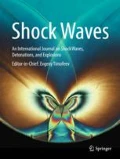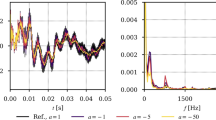Abstract
We solve the Euler equations to compute the interaction of a Mach 1.22 shock wave with a helium bubble contaminated by 28% air by mass. A ninth-order upwind scheme is used to calculate the left and the right states of the primitive variables as required by the AUSMD algorithm. The low numerical dissipation of the AUSMD algorithm makes it an ideal choice for computing long-time behavior of the bubble after the shock passes over it. The algorithm combines well with the high spectral accuracy of the ninth-order upwind scheme. The basic trends in the evolving bubble match with earlier experimental and numerical observations. Effect of numerical schemes and grid sizes is also observed for this study. The Euler solver captures a large number of small-scale rolled-up vortices originally generated by the baroclinic torque term in the vorticity transport equation and later enhanced by the Kelvin–Helmholtz instability. Numerical schlieren, mass fraction, and vorticity contour plots are used to visualize the turbulent mixing zone that is a key feature of the translating and deforming bubble.
















Similar content being viewed by others
References
Layes, G., Jourdan, G., Houas, L.: Experimental study on a plane shock wave accelerating a gas bubble. Phys. Fluids 21(074102), 1–13 (2009). https://doi.org/10.1063/1.3176474
Brouillette, M.: The Richtmyer–Meshkov Instability. Annu. Rev. Fluid Mech. 34, 445–468 (2002). https://doi.org/10.1146/annurev.fluid.34.090101.162238
Richtmyer, R.D.: Taylor instability in shock acceleration of compressible fluids. Commun. Pure Appl. Math. 13, 297 (1960). https://doi.org/10.1002/cpa.3160130207
Meshkov, Y.Y.: Instability of shock wave accelerated between two gases. NASA TT (1970). https://doi.org/10.1007/BF01015969
Markstein, G.H.: A shock tube study of the flame front-pressure wave interaction. 6th International Symposium on Combustion, Reinhold, New York, pp 387–398 (1957). https://doi.org/10.1016/S0082-0784(57)80054-X
Rudinger, G., Somers, L.M.: Behavior of small regions of different gases carried in accelerated gas flows. J. Fluid Mech. 7, 161–176 (1960). https://doi.org/10.1017/S0022112060001419
Haas, J.-F., Sturtevant, B.: Interaction of weak shock waves with cylindrical and spherical inhomogeneities. J. Fluid Mech. 181, 41–76 (1987). https://doi.org/10.1017/S0022112087002003
Tomkins, C., Kumar, S., Orlicz, G., Prestridge, K.: An experimental investigation of mixing mechanisms in shock-accelerated flow. J. Fluid Mech. 611, 131–150 (2008). https://doi.org/10.1017/S0022112008002723
Vetter, M., Sturtevant, B.: Experiments on the Richtmyer–Meshkov instability of an air/SF\(_{6}\) interface. Shock Waves 4, 247–252 (1995). https://doi.org/10.1007/BF01416035
Quirk, J.J., Karni, S.: On the dynamics of a shock–bubble interaction. J. Fluid Mech. 318, 129–163 (1996). https://doi.org/10.1017/S0022112096007069
Zhai, Z., Si, T., Luo, X., Yang, J.: On the evolution of spherical gas interfaces accelerated by a planar shock wave. Phys. Fluids 23(084104), 1–11 (2011). https://doi.org/10.1063/1.3623272
Haehn, N., Weber, C., Oakley, J., Anderson, M., Ranjan, D., Bonazza, R.: Experimental study of the shock-bubble interaction with reshock. Shock Waves 21, 225–231 (2011). https://doi.org/10.1007/s00193-011-0299-x
Ranjan, D., Niederhaus, J., Motl, B., Anderson, M., Oakley, J., Bonazza, R.: Experimental investigation of primary and secondary features in high-Mach-number shock-bubble interaction. Phys. Rev. Lett. 98(024502), 1–4 (2007). https://doi.org/10.1103/PhysRevLett.98.024502
Ranjan, D., Niederhaus, J.H.J., Oakley, J.G., Anderson, M.H., Bonazza, R., Greenough, J.A.: Shock bubble intercations : features of divergent shock-refraction geometry observed in experiments and simulations. Phys. Fluids 20(036101), 1–20 (2008). https://doi.org/10.1063/1.2840198
Bagabir, A., Drikakis, D.: Mach number effects on shock–bubble interaction. Shock Waves 11, 209–218 (2001). https://doi.org/10.1007/PL00004076
Hejazialhosseini, B., Rossinelli, D., Koumoutsakos, P.: Vortex dynamics in 3D shock–bubble interaction. Phys. Fluids 25(110816), 1–8 (2013). https://doi.org/10.1063/1.4819345
Rybakin, B., Goryachev, V.: The supersonic shock wave interaction with low-density gas bubble. Acta Astronaut. 94, 749–753 (2014). https://doi.org/10.1016/j.actaastro.2013.09.002
Zhai, Z., Wang, M., Si, T., Luo, X.: On the interaction of a planer shock with a light polygonal interface. J. Fluid Mech. 757, 800–816 (2014). https://doi.org/10.1017/jfm.2014.516
Si, T., Long, T., Zhai, Z., Luo, X.: Experimental investigation of cylindrical converging shock waves interacting with a polygonal heavy gas cylinder. J. Fluid Mech. 784, 225–251 (2015). https://doi.org/10.1017/jfm.2015.581
Luo, X., Wang, M., Si, T., Zhai, Z.: On the interaction of a planer shock with an \(\text{ SF}_{{6}}\) polygon. J. Fluid Mech. 773, 366–394 (2015). https://doi.org/10.1017/jfm.2015.257
Zou, L., Liu, C., Tan, D., Huang, W., Luo, X.: On interaction of shock wave with elliptic gas cylinder. J. Vis. 13, 347–353 (2010). https://doi.org/10.1007/s12650-010-0053-y
Georgievskiy, P.Y., Levin, V.A., Sutyrin, O.G.: Interaction of a shock with elliptical gas bubbles. Shock Waves 25, 357–369 (2015). https://doi.org/10.1007/s00193-015-0557-4
Lindl, J.: Development of the indirect-drive approach to inertial confinement fusion and the target physics basis for ignition and gain. Phys. Plasmas 11(2), 3933–4024 (1995). https://doi.org/10.1063/1.871025
Ranjan, D., Oakley, J., Bonazza, R.: Shock–bubble interactions. Annu. Rev. Fluid Mech. 43, 117–140 (2011). https://doi.org/10.1146/annurev-fluid-122109-160744
Bagabir, A., Drikakis, D.: Numerical experiments using high-resolution schemes for unsteady, inviscid, compressible flows. Comput. Methods Appl. Mech. Eng. 193, 4675–4705 (2004). https://doi.org/10.1016/j.cma.2004.03.012
Giordano, J., Burtschell, Y.: Richtmyer–Meshkov instability induced by shock-bubble interaction: numerical and analytical studies with experimental validation. Phys. Fluids 18(028603), 1–10 (2006). https://doi.org/10.1063/1.2185685
Marquina, A., Mulet, P.: A flux-split algorithm applied to conservative models for multicomponent compressible flows. J. Comput. Phys. 185, 120–138 (2003). https://doi.org/10.1016/S0021-9991(02)00050-5
Kundu, A., De, S.: Application of compact schemes in the CUSP framework for strong shock-vortex interaction. Comput. Fluids 126, 192–204 (2016). https://doi.org/10.1016/j.compfluid.2015.11.018
Kundu, A., De, S.: Navier–Stokes simulation of shock-heavy bubble interaction: comparison of upwind and WENO schemes. Comput. Fluids 157, 131–145 (2017). https://doi.org/10.1016/j.compfluid.2017.08.025
Kundu, A., De, S.: High resolution numerical simulation of a shock-accelerated refrigerant-22 bubble. Comput. Fluids 193, 1–14 (2019). https://doi.org/10.1016/j.compfluid.2019.104289
Carpenter, M.H., Kennedy, C.A.: Fourth-order 2N-storage Runge–Kutta schemes. NASA TM 109112 (1994). https://ntrs.nasa.gov/citations/19940028444
Kundu, A., De, S.: High-resolution Euler simulation of a cylindrical blast wave in an enclosure. J. Vis. 18, 733–738 (2015). https://doi.org/10.1007/s12650-014-0254-x
Kim, K.H., Kim, C.: Accurate, efficient and monotonic numerical methods for multi-dimensional compressible flows. Part II: multi-dimensional limiting process. J. Comput. Phys. 208, 570–615 (2005). https://doi.org/10.1016/j.jcp.2005.02.022
Wada, Y., Liou, M.-S.: An accurate and robust flux splitting scheme for shock and contact discontinuities. SIAM J. Sci. Comput. 18(3), 633–657 (1997). https://doi.org/10.1137/S1064827595287626
Halder, P., De, S., Sinhamahapatra, K.P., Singh, N.: Numerical simulation of shock–vortex interaction in Schardin’s problem. Shock Waves 23, 495–504 (2013). https://doi.org/10.1007/s00193-013-0448-5
De, S., Murugan, T.: Numerical simulation of shock tube generated vortex: effect of numerics. Int. J. Comput. Fluid D 25(6), 345–354 (2011). https://doi.org/10.1080/10618562.2011.600694
Murugan, T., De, S., Dora, C.L., Das, D.: Numerical simulation and PIV study of compressible vortex ring evolution. Shock Waves 22, 69–83 (2011). https://doi.org/10.1007/s00193-011-0344-9
Murugan, T., De, S., Dora, C.L., Das, D., Kumar, P.P.: A study of the counter-rotating vortex rings interacting with the primary vortex ring in shock tube generated flows. Fluid Dyn. Res. 45(025506), 1–20 (2013). https://doi.org/10.1088/0169-5983/45/2/025506
Dora, C.L., Murugan, T., De, S., Das, D.: Role of slipstream instability in formation of counter-rotating vortex rings ahead of a compressible vortex ring. J. Fluid Mech. 753, 29–48 (2014). https://doi.org/10.1017/jfm.2014.353
Lele, S.K.: Compact finite difference schemes with spectral-like resolution. J. Comput. Phys. 103, 16–42 (1992). https://doi.org/10.1016/0021-9991(92)90324-R
Latini, M., Schilling, O., Don, W.S.: Effects of WENO flux reconstruction order and spatial resolution on reshocked two-dimensional Richtmyer–Meshkov instability. J. Comput. Phys. 221, 805–836 (2007). https://doi.org/10.1016/j.jcp.2006.06.051
Samtaney, R., Pullin, D.I.: On initial-value and self-similar solutions of the compressible Euler equations. Phys. Fluids 8, 2650 (1996). https://doi.org/10.1063/1.869050
Acknowledgements
The authors gratefully acknowledge their access to the High Performance Computing Facility of CSIR-CMERI. In particular, the authors are immensely indebted to Anupam Sinha, of the Aerosystems Laboratory of the Institute, who has skilfully developed and maintained this facility. The author thank Sudipta De, former principal scientist at CSIR-CMERI, for his enormous contribution in developing the inhouse compressible flow solver.
Author information
Authors and Affiliations
Corresponding author
Additional information
Communicated by R. Bonazza.
Publisher's Note
Springer Nature remains neutral with regard to jurisdictional claims in published maps and institutional affiliations.
Rights and permissions
About this article
Cite this article
Kundu, A. Numerical simulation of a shock–helium bubble interaction. Shock Waves 31, 19–30 (2021). https://doi.org/10.1007/s00193-021-00996-x
Received:
Revised:
Accepted:
Published:
Issue Date:
DOI: https://doi.org/10.1007/s00193-021-00996-x




